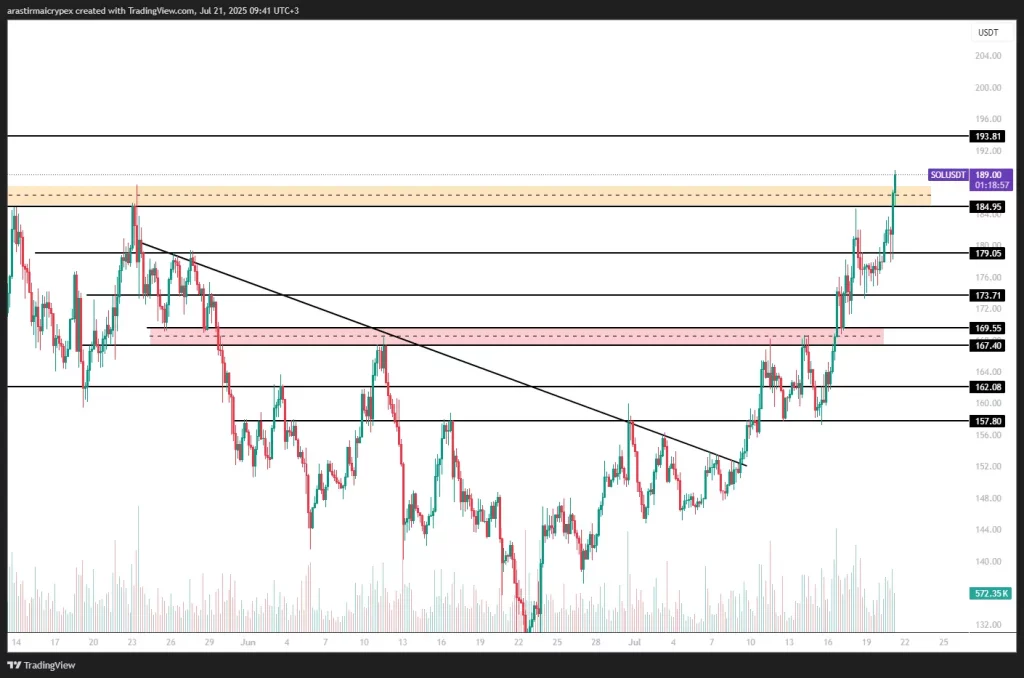Trump Signs US First Crypto Bill
US President Donald Trump has signed the GENIUS (Guiding and Establishing National Innovation for US Stablecoins) Act, the country’s first comprehensive crypto law, establishing a federal framework for stablecoins. The law requires all stablecoins to be fully backed by US dollars or similar liquid assets, subject to annual audits, and impose specific rules for foreign issuers. Speaking at the ceremony, Trump described the legislation as a “major victory for the crypto industry” and criticized the previous administration’s approach to the sector, referencing the Biden era.
The GENIUS Act reached Trump’s desk after passing the Senate by a vote of 308-122 in the House of Representatives. Prominent crypto figures such as Tether CEO Paolo Ardoino and Coinbase CEO Brian Armstrong were also present at the ceremony. Circle CEO Jeremy Allaire called the law “one of the most transformative legislation in decades.” Meanwhile, some Democrats have highlighted conflicts of interest and national security risks associated with stablecoin projects like World Liberty Financial USD, which has ties to the Trump family.
UK Aims to Close Budget Deficit with £5 Billion Bitcoin Sale
UK Treasury Secretary Rachel Reeves is considering selling £5 billion worth of Bitcoin seized by the government in an effort to combat a £20 billion deficit in the public finances. Much of this Bitcoin was seized in 2018 as part of an investigation into a Chinese Ponzi scheme. The assets, valued at around £300 million at the time, have surpassed £5 billion today thanks to Bitcoin’s surge. While this move may seem appealing as a way to ease the budget amid rising borrowing costs and low growth expectations, experts warn that potential long-term gains could be missed.
Some economists argue that this sale could lead to a large opportunity cost in the future, similar to Gordon Brown’s gold sales in the 2000s. Meanwhile, uncertainties surrounding compensation for Ponzi victims and identity verification issues remain unresolved. While countries like the US have conducted similar sales, historical data suggests that Bitcoin holdings gain much more value over time. While countries like El Salvador have included Bitcoin in their national reserve assets, the UK’s decision to liquidate it entirely is drawing criticism.
SharpLink and Bitmine Heat Up the Race for Ethereum Treasures with 500,000 ETH
SharpLink Gaming and Bitmine Immersion Technologies have accumulated over 500,000 ETH in total, strengthening ETH’s position as a strategic asset in corporate treasuries. Both companies are attracting attention by surpassing the Ethereum Foundation’s holdings, positioning ETH not only as speculative but also as a profitable asset on a balance sheet. SharpLink holds 280,706 ETH, while Bitmine leads with 300,657. Both companies are increasing their returns by staking these assets.
Bitmine President Tom Lee likens the firm’s strategy to MicroStrategy’s Bitcoin policies, eventually aiming for a 5% ownership share. Ethereum co-founder Joseph Lubin describes the competition as “fierce competition but also potential for collaboration.” This ETH accumulation has pushed Ethereum prices higher, with ETH up 6.5% in the last 24 hours, reaching $3,800. Institutional ETH accumulation is now emerging as a new driver of market momentum.
Ethereum to Launch Fusaka Upgrade in November; EIP-7907 Postponed
Ethereum’s next major network upgrade, Fusaka, will be implemented on the mainnet between November 5th and 12th. Developers have decided to remove the controversial EIP-7907 proposal from this upgrade due to technical complexity and timing risks. The proposal called for increasing the smart contract size limit by 24KB. However, due to concerns that this change could delay the current process, it has been postponed and brought forward for the next upgrade, “Glamsterdam.”
The current focus is on stabilizing the upgrade with Devnet-3, which launches on July 23rd. This will be the final development phase of Fusaka before it moves to public testing. The development teams are continuing to address various testnet issues, including validator synchronization, node crash errors, and metadata issues. The goal is to have clients ready by the end of September, followed by final stress tests with the Holesky testnet, and a smooth transition to the launch in early November.
Tether and Circle Are Preparing for the New US Stablecoin Law
The GENIUS Act, signed by US President Donald Trump, marked a major turning point in the stablecoin market. Tether CEO Paolo Ardoino announced that his company will bring USDT to the US market by making it compliant with these new regulations. Tether, currently based in El Salvador, aims to achieve full compliance with US regulations within three years. Ardoino also stated that Tether plans to launch a new US-specific stablecoin. With this move, Tether aims to further establish itself in the US market for both international remittances and corporate solutions.
On the other hand, Circle CEO Jeremy Allaire argued that these developments are not a threat to his company, but an opportunity. Circle stands out as a company that has been subject to public scrutiny and has worked in compliance with regulatory authorities for years. Allaire stated that the GENIUS Act legally grounds Circle’s business model, which will further expand the company’s corporate partnerships. Both CEOs were present at the White House at the ceremony where Trump signed the GENIUS Act. The moment marked a historic moment in which two industry rivals have rarely met on the same stage.
MEI Pharma Makes $100 Million Litecoin Move
MEI Pharma has become the first publicly traded US company to add Litecoin to its treasury. The Nasdaq-listed biotechnology firm announced that it will acquire Litecoin through a $100 million private equity investment (PIPE). Crypto capital markets firm GSR, which led the investment, will serve as MEI’s digital asset strategic advisor and treasury manager. Litecoin creator Charlie Lee will also join MEI’s board of directors once the deal closes.
This move demonstrates the company’s reshaping of its traditional drug development focus around digital assets. With GSR’s contribution, MEI plans to manage Litecoin securely and efficiently at the institutional level. Thanks to Litecoin’s low-cost, fast, and global transfer capabilities, MEI aims to integrate crypto with traditional finance. The company’s share price has increased by 147% since the beginning of the year, and this strategic transformation positions MEI at the crypto-finance intersection.
Charles Schwab Enters Crypto
Charles Schwab, a leading US brokerage firm, is preparing to launch spot Bitcoin and Ethereum trading. Speaking to CNBC, CEO Rick Wurster stated that this move will put the company in direct competition with crypto giants like Coinbase. Schwab emphasizes that many of its clients already invest in crypto but do so through other platforms. Wurster says they want to bring their clients’ digital assets to Schwab, “the place they trust.” The company’s goal is to integrate crypto alongside traditional assets like stocks and bonds.
Schwab clients currently hold more than 20% of all crypto ETPs in the market, equivalent to approximately $25 billion. However, this figure is a small fraction of Schwab’s total $10.8 trillion in assets under management. The company also plans to launch its own stablecoin soon. This move follows the recent passage of the GENIUS stablecoin legislation by the US Congress. Meanwhile, Schwab reported over $2 billion in profit in its second-quarter financial results and added 1.1 million new accounts, bringing total client assets to $10.76 trillion. Schwab and Coinbase shares also hit record highs following these developments.
FTT Jumps 43% on False Trump Pardon News
FTX’s native token, FTT, surged 43% to $1.30 following false reports that former CEO Sam Bankman-Fried had been pardoned by Donald Trump. However, the Justice Department’s official pardon list contains no mention of Bankman-Fried. The rumor spread rapidly on social media and briefly revived investor interest. This surge further illustrates the power of speculation-based price movements in the crypto market.
Bankman-Fried, who was sentenced to 25 years in prison for fraud related to the FTX collapse, is currently actively lobbying Trump for a pardon. His family and political connections are also involved in the process. However, experts see a low likelihood of pardon due to Trump’s “interest-based” approach to pardons and Bankman-Fried’s past donations to Democrats. While crypto figures such as Arthur Hayes and Ross Ulbricht have received pardons in the past, the process is thought to be much more difficult for SBF.
—————————————————————————————————
BITCOIN (BTC)
Bitcoin is trading at $119,055 as of morning hours, gaining 1.49%. The price is holding above the $118,775 support and moving towards the $120,510 resistance. If this level is broken, the $ 123,000 area can be followed as the next resistance.
In case of a possible downward pressure, the $ 118,775 level stands out as the first support, while in case of closing below this level, the $ 115,896 and $ 111,924 levels can be watched as support.
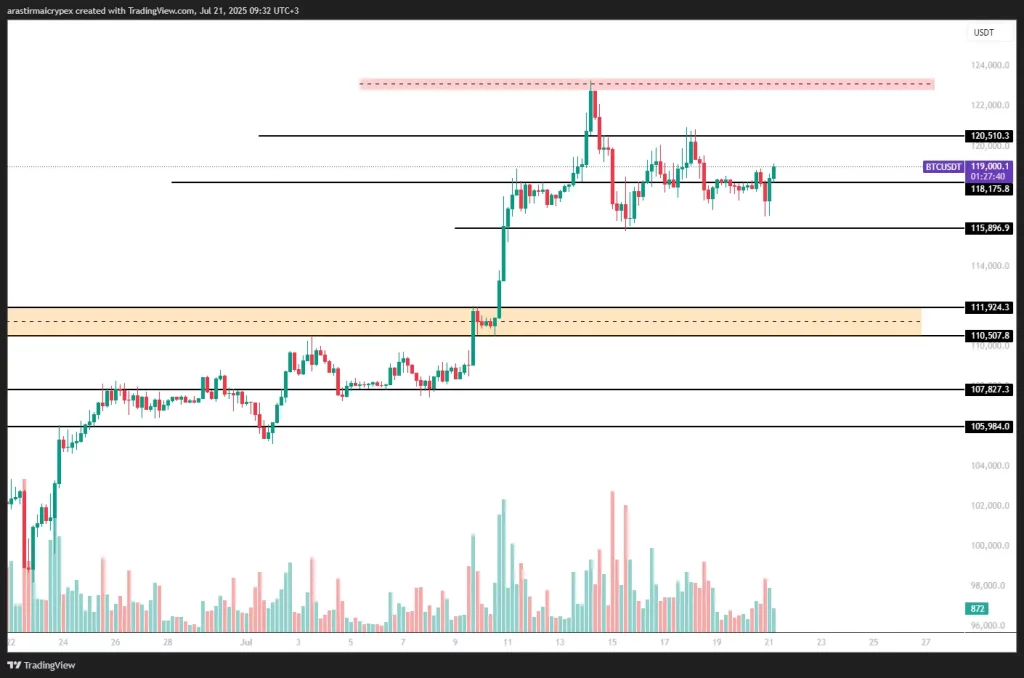
ETHEREUM(ETH)
ETH is priced at $ 3,800 with a 1.10% gain in value as of the morning hours. Displaying a strong upward trend, ETH has recently left many resistance levels behind and maintains its hold above $ 3,746. If it holds above this level, the $ 4,011 level stands out as the next important resistance. In case of possible downward corrections, $3,535, $3,434 and $3,285 levels can be monitored as support, respectively. Although the general outlook is positive, it should also be taken into account that profit taking may occur in the short term as the price approaches the $4,000 band.
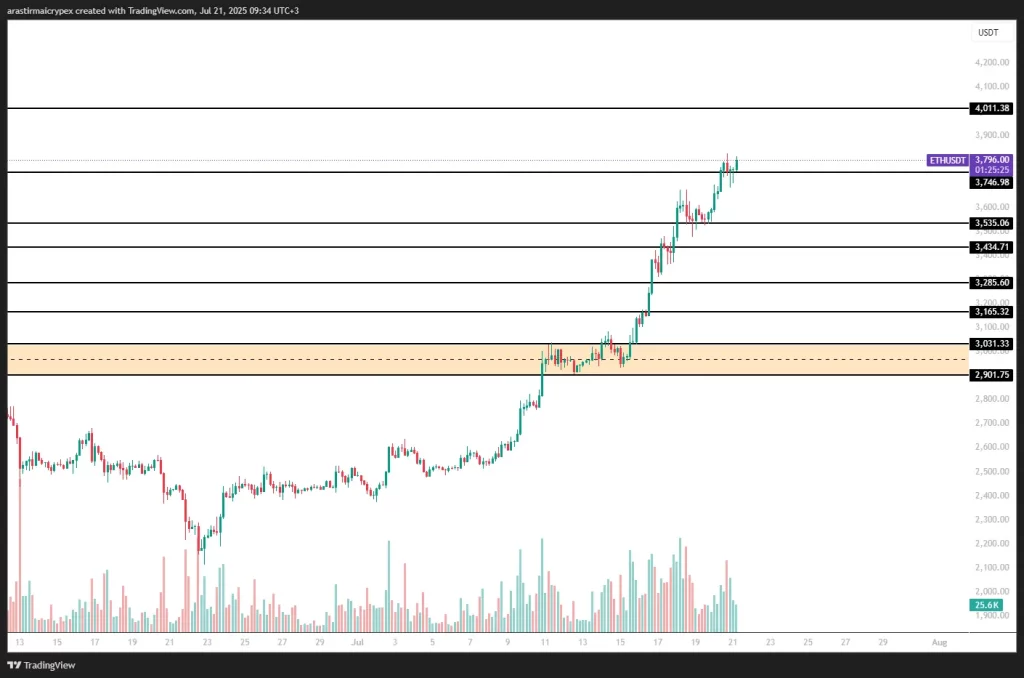
RIPPLE(XRP)
XRP is priced at $ 3.55 with a 2.98% gain as of the morning hours. Displaying a strong uptrend, XRP continues its upward momentum by breaking through the resistance zone in the $ 3.3976 – $ 3.2824 range with volume. Currently, the $ 3.6107 level is followed as the nearest resistance, and if this level is broken, the price has the potential to move towards $ 3.80. In case of possible pullbacks, the $ 3.3976 level stands out as the first support, while below this level, $ 3.2824 is a strong support.
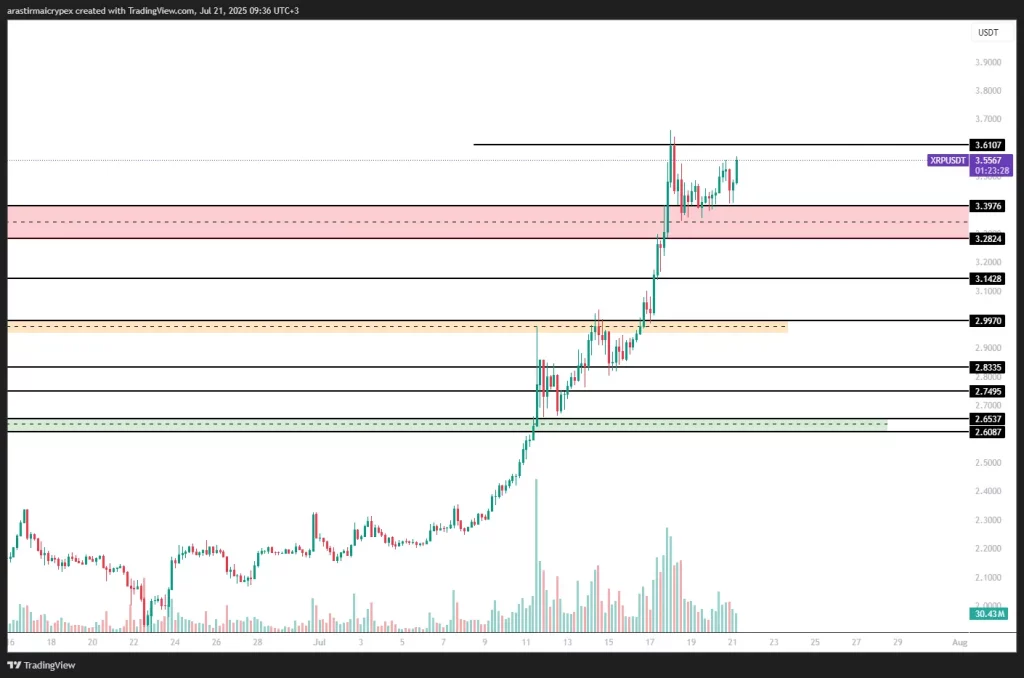
AVALANCHE(AVAX)
AVAX is trading at $25.72 levels with a 2.76% gain as of the morning hours. The price has surpassed the $24.97 resistance and increased its upward potential towards the $26.26 region. This level draws attention as the strong resistance area where the price was rejected in May.
In the short term, the $24.97 level may work as support. Below this level, the $23.91 and $23.22 levels can be watched as other support areas, respectively. If buying appetite continues, closing above $26.26 could carry AVAX to new local highs.
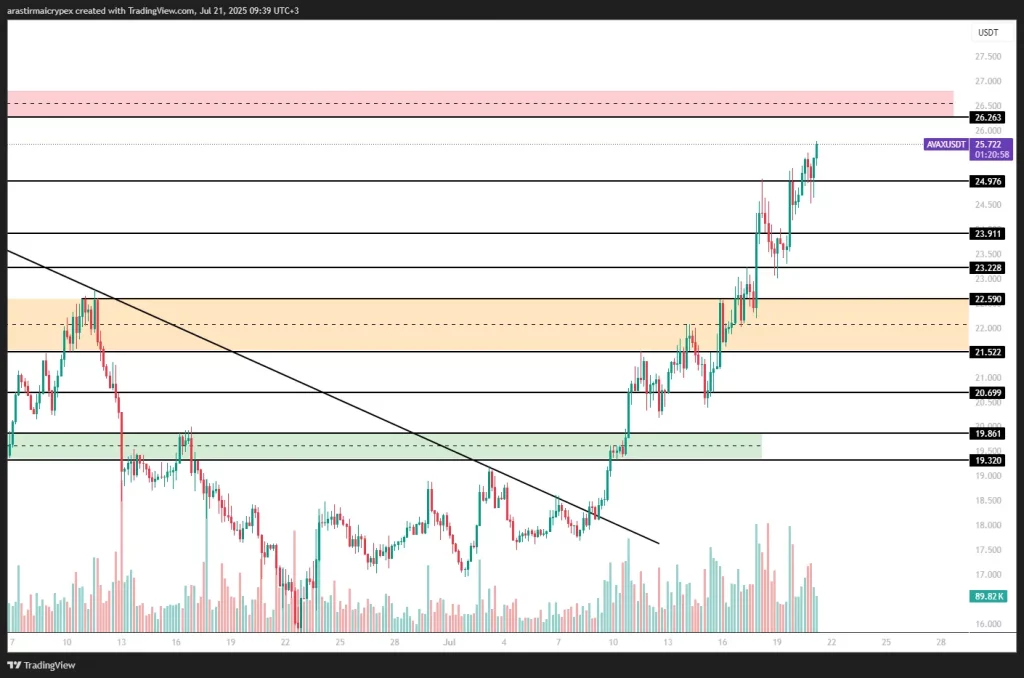
SOLANA(SOL)
SOL is traded at $ 188 levels with a 4.16% gain as of the morning hours. The price has climbed above the $ 184.95 resistance and approached the strong resistance zone at $ 193.81. This level draws attention as an area where sharp selling has occurred in the past and selling pressure has intensified.
If the rise continues, the $ 193.81 level can be watched as the main resistance. In possible corrections, the first support point will be $ 184.95, while the $ 179.05 and $ 173.71 levels can be followed below.
